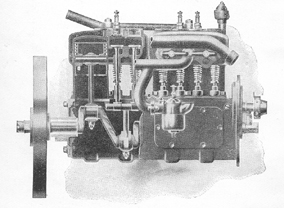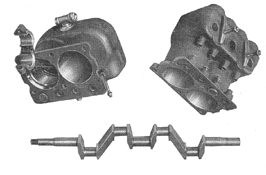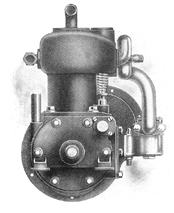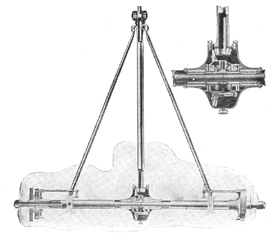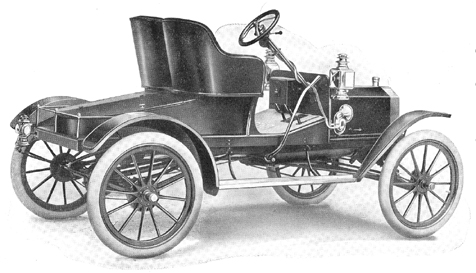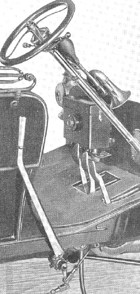1907 модельный год продолжался выпуском автомобилей 1906 года. Был прекращён выпуск двухцилиндровой "Model F" и
увеличен выпуск "Model K", существенно изменённой по сравнению с моделью 1906 года. В апреле 1907 года начался выпуск "Model R".
"R" был более усовершенствованной версией Модели "N", и оказался настолько популярным, что был снова пересмотрен,
став Моделью "S" в августе 1907, когда был прекращен выпуск "Model R".
В июне 1907 "Model K" был предложен также как родстер c названием "6-40" (6 цилиндров, 40 л.с.).
|
|
| THE FORDS FOR 1907-08, MODELS K, N, and R | |
|
Ford cars have, from the very first, occupied an enviable position. Paradoxically,
their fame has been promoted by the systematic opposition of less progressive makers and
their agents-an opposition that has been exerted with equal force and futility against each
succeeding Ford Model. The head and front of our offending seems to be that we insist on
leading rather than following the trend of automobile design and development.
|
While all competent gas engine authorities recognize the "six" as the mechanical
ultimate, not all buyers might be expected to understand or appreciate its superiority
over the "four" and other types. Fact is, six cylinders are not so necessary until we reach
high powers and must use cylinders of large bore to obtain the desired power in four. Our
competitors, lacking the necessary experience and seeing only troubles for the maker in
sixes, sought to stem the tide of demand for that type—as usual with the result of starting
a public investigation and thereby exploiting the very thing they sought to disparage.
Foreward!
The two models—the "K" 6-cylinder 40 h.p. touring car and the "N" 4-cylinder
15 h.p. runabout comprise the Ford line of 1907.
|

The revised Model K for 1907 A new body, a longer wheelbase, and other improvements were made over the 1906 model. |
|
The Six-Cylinder Idea
The six-cylinder idea has fully demonstrated its superiority and has so popularized
itself that other makers have either entered the six-cylinder field or find it necessary to make
excuses for not doing so. The "complications" have proven to be only those of making—they are
the manufacturers' troubles and they minimize the troubles of owner and driver to a degree that
can be fully appreciated only by the man who pays the bills.
Life and Service That the life of a car equipped with this perfectly balanced, vibrationless six-cylinder motor will be more than twice that of one equipped with a four-cylinder motor of greater cylinder bore and the same power has been demonstrated as far as a season's work can demonstrate it. While ordinarily, a car has deteriorated very considerably after a season's use, every one of the Ford "Sixes" is worth actually more today than when they first left the factory. The season's work has resulted in improving the smoothness, flexibility, and the road-ability of the car This item of longer life, more than the mere matter of present performance, appeals to the astute buyer. As time proves all theories right or wrong, so time will bring the final adoption of the six-cylinder idea in all high powered touring cars. |
Ford Leads Not all makers will admit the superiority of six-cylinders. This is natural. There is a reason. If a maker can see the road first and lead, it is a feather in his cap. That was the Ford position. Other makers will follow only when compelled to do so by an overwhelming demand—they don't like to admit they copied, though all have had to, sooner or later, in the past. It is significant that none tries to disparage the six-cylinder motor; their arguments are confined to the weak protest that "it is not so very much better" and a few rambling statements about its supposed complications which will not hold water. We are free to admit that it is a more difficult motor to build in the first place-but that is our problem, not the customer's. No argument against the six, in favor of the four-cylinder engine, but will serve with even greater force to recommend the single as against the four. So they all fall short of convincingness. Motor The motor of the 1907 "K" is the same as that of 1906 except that its power has been increased about 20 per cent. By refinement of details. The best proof of the entire satisfaction derived from the six-cylinder Ford cars sent out last season is to be found in this fact, that we could think of no important improvement that could be made in the motor design. |
As the art advances, however, there appear ways of refining and thereby improving.
The 1907 Model K has gone through this process and we believe it is now the finest product
throughout that can be had at any price.
Pump The water pump is of the centrifugal type instead of the gear-pump formerly used and the circulation system throughout has been refined and improved, taking advantage as much as possible of the thermo-syphon tendencies of the cooling liquid. The pump, as formerly, is positively driven from the cam-shaft. Lubrication The lubrication system of the 1907 car leaves nothing to be desired. A positive mechanical oiler, with a separate pump for each tube, eccentrically operated, serves every cylinder independently. The oil level in the base is maintained by another feed tube and still another automatically lubricates the universal joint, drive shaft, and finally the rear axle bearings. The oil flow starts and stops with the motor so there is economy as well as certainty. The tube leading to the engine base enters directly over the half-time gears, which latter are thereby bathed in oil at all times. The oiler is located on the left side of, and on, the engine base so that the heat from the motor keeps the thickness of the oil at the same consistency, regardless of weather conditions. The location of the oiler under the hood and also the sight feeds for adjustment, puts it where it belongs; the fad for having everything on the dash has run its course—an oily floor and dash is ruinous to gowns and robes. Ignition The double ignition system with duplicate set of spark plugs was a Ford innovation and was roundly criticized by other makers early in the season. It is now announced as a feature in those same cars for next season. This extra set of plugs absolutely ensures the driver against ignition troubles, one set being always kept clean by the burning of the charge. |
Magneto
The high tension magneto used on Ford cars has proven an unqualified success.
We have long since gotton all the "bugs out of it" and we have no hesitation in saying it
is the best magneto for automobile motor ignition in the world.
Carburetor The Carburetor is similar to that of the 1906 model but improved in starting qualities and flexibility so that it accurately and automatically compensates for every degree of motor speed. Moving the throttle lever one notch, instantly makes itself felt and each notch thereafter for the full radius of the quadrant, gives the same degree of acceleration or retarding of car speed. The air intake tube terminates in a drum around the exhaust pipe, which drum has an opening on the side opposite the carburetor, so that the cold air is first drawn around the hot exhaust pipe. This makes for economy of fuel and a more uniform mixture. The exhaust pipe is now carried down below the transmission frame so as to be clear of all working and adjustable parts. It is larger than formerly, giving freer exhaust with the minimum of back pressure. Transmission The planetary transmission is retained for the simple reason that, after watching closely the performance of these cars and seeing the excellent condition of all of them at the end of the season, we believe no other form of transmission now in use could have given such uniform results, with so few gear, transmission and axle troubles. Instead of the former rigid connection between the motor shaft and transmission shaft, we |
have put in the 1907 car a flexible joint. This is not a universal joint in the ordinary sense of the term, but it permits to a sufficient degree of a universal movement of the shafts at the intersection and fully compensates for all possible distortions or strains caused by hard driving over rough roads. The present construction leaves nothing to be desired and is as nearly perfection as it is possible to attain. Weight
While the power has been increased fully 20 per cent, the weight of the car has
been increased but a few pounds—the 1907 "K" weighs 2600 lbs. as against the 2500 of the
1906 model.
Gear Ratio For the benefit of customers living or touring in mountainous districts, where the high speed possibilities of this car cannot be safely utilized, we give an option of two different gear ratios, 3 to 1 or 3-3/4 to 1. The standard gearing is 3 to 1, and this will be furnished unless otherwise specified in the order. Special Steels Chrome-Nickel steel, our own formula, is used in all shafts, gears, axles, valves and every other working part. Steering Gear The incomparable Ford steering reduction gear has been retained as have all other chassis features except those above designated; and time and service over all kinds of roads in all parts of the country and in the hands "of all kinds of drivers" have shown no place where improvement could be made. Body The only radical change in the 1907 "K" is in the body design, the approved round-corner tonneau type with straight sides having been adopted. The tonneau dimensions have been increased by a six-inch increase of wheel base. Three very large persons or four of ordinary size can sit comfortably on the rear seat. By carrying the side lines straight to the front seat, more leg room is provided so that every passenger faces directly front instead of being compelled to sit half sidewise, as in most other cars. The front seat also is wider than the ordinary and the divided seat has been discarded in favor of the more popular undivided type. |
Frame The wheel base has been increased, as mentioned above, to 120 inches, 6 inches longer than that of 1906. To compensate for this extra span, the frame is made of heavier gauge material and deeper channel—5 inches in the wider part. A special high grade nickel-steel is used in the frame. Enclosed Fenders The new Fenders on the 1907 car are a delight to the motorist. Patent leather wings protect the hood and body from mud or sand thrown by either front or rear wheels, while a metal shield extends the full length of the car, joining the running board to the body, thereby excluding all dirt and oil. "Miss Phoebe Snow" might ride in this car indefinitely without soiling her immaculate gown or dainty gloves. Speed The increased power makes the new "K" capable of 60 miles an hour with full load of five adults and the combined flexibility of the six-cylinder motor and magneto enables the driver to throttle down to a crawl without the necessity of changing gears or releasing the clutch. Price, $2800 Increased cost of special materials and of manufacture, added to the fact that the margin of profit in the 1906 "K" was not even a "fair" one, has made an increase in price necessary. On the other hand, we assert without fear of contradiction that in no other car selling for less than $5,000 can there be had so much service, so much reliability, and so much luxury as in this latest model "K" Ford, which sells at $2800.00. 1,000 Six-Cylinder Cars We have manufactured 1,000 more six-cylinder cars than any other concern in the world. We are now well under way on 1,000 of this latest model. The quantities alone make Ford prices possible and we will see to it that better material, better workmanship, and a more rigid system of inspection can not be put into the making of an automobile. A Profitable Investment That it pays to buy Ford cars is proven by the fact that it has always been necessary to increase the price of each new model after the first batch had been turned out, and at a time when others found it necessary to reduce prices in order to compete with the Ford product. We have always erred on the side of low, rather than high, prices. The famous Ford Runabout is only one of many examples. Every 1906 model "K" is today worth more than on the day it left the factory-prices of material have increased so that it could not now be profitably marketed for the price at which it was sold. And the 1907 car will be found to have increased as much in value by end of its first season. In other words, the purchase of a Ford car is an investment, not an expense. |
1907 Model "N" 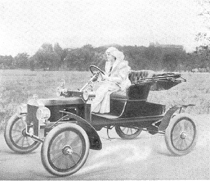
In this Model there has been no change from the original car shown at the New
York and other shows last January, (since when its fame has become world wide) except that,
as it is now possible to obtain special steels in quantities sufficient to meet our enormous
demands, nickel steel is used for all gears and shafts wherever that metal can give greater
efficiency.
|
A moment's thought will convince you this is not surprising. Before we dared begin
building cars in lots of ten thousand, staking the entire resources and the reputation of the House
of Ford on that move, we must be certain we had an automobile that was as nearly perfect as
it was possible to make it and that the design was not only up-to-date, but so far in advance
of the ordinary car as to remain standard for at least five years; for ten thousand cars is
not our final goal. We confidently expect to build 50,000 of these cars before it is necessary
to make any radical change in the chassis design—if, indeed, it ever is. At the price the
market is practically unlimited; the price creates the demand, the certain demand makes it
possible to plan for enormous quantity production, and producing in such numbers in turn,
makes the price possible—profitable though the margin on each car is necessarily small.
|
Model "K", Specifications
MODEL—"K." |
Model "N" Specifications
MODEL--"N." |
Model "R"
Ever since the Ford Model "N" Runabout Was first announced and more especially
since the quality and powers of that car have become known to the world of motordom there
has been a large and increasing demand for a car of similar construction, power and
endurance, but more pretentious in outward appearance. A runabout more richly dressed and
equipped With those frills and fussings that are dear to the hearts of more fastidious
owners persons who like something specially nice and to whom price, while a consideration,
is a matter of secondary importance. |
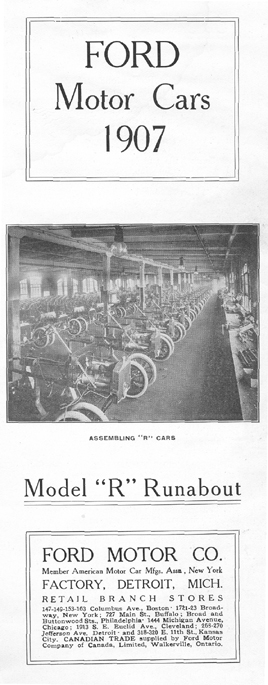 The Ford Model "N" motor and chassis has proven to have more strength and power than is necessary under any conditions for the size of the car, It was not necessary, therefore, to apply a larger motor or heavier axles, frame or transmission to produce the more pretentious appearing Model "R." |
The chief points of difference between the two models are as follows: 30" x 3"
tires which enhance the speed qualities of the machine forty-five miles an hour easily,
down to four miles on high gear by throttle control alone.
Model "R" four-cylinder, vertical; located longitudinally under hood at the front. Cylinders cast in pairs. Bore, 3-3/4 inch; stroke, 3-3/8 inch; rated horse power at normal speed, 15. (Under series of tests connected with and driving dynamo develops 18.4 h.p.) Aluminum crank case. Crank shaft bearings, highest grade Babbitt metal; exceptionally long. Cam shaft bearings, bronze. |
CRANK SHAFT Drop-forged steel, specially heat-treated by our own
process. All bearing surfaces ground to half-a-thousandth of an inch accuracy. Lubrication MECHANICAL OILER A faultless lubrication system is afforded by a mechanical oiler with sight feeds for regulating the flow. One tube serves to maintain a uniform level in the engine base and the other leads to the ball-housing which encloses the universal joint in the cardon shaft. All engine parts-crank shaft and connecting-rod bearings, piston pins, cylinders, cams, and valve lifters, are lubricated by the "splash" system. Owing to the fact that the s troke in this engine is shorter than the bore and that the pistons project into the base |
at the end of each stroke, the splash system of lubrication leaves nothing to be desired.
It is certain and simple. The oil begins to flow when the engine starts and while it is running
the supply is in direct proportion to speed of the motor---in other words, to exactly meet
its requirements. When the motor stops the oil ceases to run so that once the feed is
regulated a constant level can be maintained in the engine base regardless of variation
of speeds. A partition mid-way between front and rear of the engine base prevents the oil
flooding the rear cylinders when climbing steep grades and keeps the two pairs equally
lubricated. Oil cups are provided at every bearing point throughout the car-even at the
spring connections. Provision is made both in the transmission gear and in the differential
and bevel gear housing of the rear axle, to pack these parts with heavy grease, one supply of
which will last for several weeks. 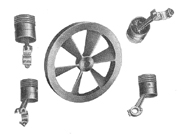 Final Drive |
IGNITION By jump spark; current supplied by batteries--standard
equipment (Model "R") one set of six Columbia dry cells and one six-volt storage battery.
Quadruple coil in handsome case located on the dash, Switch on front of case. Each coil
unit is separate and complete in itself and any unit may be removed or replaced without
disturbing the others. High tension wires well insulated and carried in fiber brackets so
that disarrangement or short-circuiting is impossible. CARBURETOR Float feed; automatic; specially designed for this car. Gasoline tank located under the seat with gravity feed to carburetor. Cooling
Perfect cooling under all conditions is afforded by a most efficient vertical
tube radiator which forms the front of the hood and in which the centrifugal pump is
incorporated. The circulation system has been carefully worked out so that the water is
constantly in motion and it is impossible for the engine to overheat no matter how hot
the weather or how long it may run idle or on the low gear.
The transmission is of the Ford spur-planetary type, nearly eight thousand of which are now in use and which have proven so wonderfully efficient and durable. Low speed and reverse clutches are of the fiber-lined, steel band type, which take hold smoothly and which spring away from the drums when disengaged so as to prevent "dragging" and the consequent waste of power. |
The high-speed clutch is of the multiple disc type with fiber discs interposed
between smooth cast iron discs. A transmission gear is almost unnecessary
on this Model "R" car as the excessive power of the engine enables the car to climb almost
any hill or negotiate the muddiest or sandiest roads on the high gear-and at a slow speed
if the driver so desires. The low gear is seldom or never used except for the first twenty
or thirty feet when starting from a stand-still. It will be seen, therefore, that this
transmission should outwear almost any other part of the car. Final Drive The Ford triangular drive system is patented in every country in the world. It is the only system in which all driving shafts, universal joints, gears and other moving parts are enclosed in a dust proof and oil tight housing from transmission gear to the hub caps of the wheels. The drive is direct to the center of the chassis regardless of whether the car is running straight or turning corners; and only one universal joint is necessary. A ball-and-socket connection between the tubular torsion member and the transmission frame allows the axle to oscillate in any direction and thereby relieves the passengers of all strains and shocks due to unevenness of the road. It also permits of the use of full elliptic springs, flexibly connected to the frame brackets instead of the rigid connection necessary when the driving strain must be transmitted through the medium of the springs.
|
This system is broadly covered by letters patent in all countries and is used in all Ford models. The universal joint comprises four members-the two drop-forged steel sections and the halves of the split bronze retaining ring. It is, at the same time, the simplest, most efficient and most durable universal joint ever devised and as it is automatically lubricated at all times, the owner "never knows it is in the car." The drive shaft bearings are of babbitt, carefully reamed and fitted and the oil from the universal joint flows constantly down through these bearings and into the differential housing. Rear Axle The rear axle proper is the well known Ford design, the driving members being enclosed in a tubular steel housing, press-fitted and riveted to the cast steel sections of the differential case, Hyatt roller bearings of the indestructible type are fitted at both ends of the live members. The differential gear is of the three pinion, bevel type; all gears made from special high-grade, drop-forged, steel blanks. The driving pinion and main bevel gear are drop-forged from special chrome nickel steel, teeth accurately planed and case hardened, The axle may be taken apart in a few minutes, differential gear and other parts removed and examined. Front Axle The front axle of the Model "R" is a marvel of the drop-forging art. The entire axle is drop-forged in one piece from special steel and is heat-treated after forging. It is in "I"-beam section-the form which gives the maximum of strength with the minimum of weight. The worst that can happen to this axle, even in a collision with a telegraph pole, is to bend it; and even if bent double, it can be heated in a blacksmith's forge and straightened without having suffered any actual injury. Steering knuckles and spindles, are drop-forged from special steel, in one piece. Front wheels are carried on large ball-bearings-balls being more suitable for supporting the end-thrusts occasioned by steering. Steering Gear The Ford Reduction-Gear steering device is the only really new thing in this line that has been developed in several years. Like the rear axle, it is being patented in all countries, and we believe it is the most satisfactory solution of the steering problem that has yet appeared. It is just sufficiently irreversible to relieve the driver of all road worries and at the same time yields enough to irregularity of the ruts to save the car from the many shocks and twists from which it would otherwise suffer, The gears, instead of being located below the frame where they become clogged with mud and cut by grit and dust, are placed at the top of the post just within the hub of the steering wheel. Ball joints connect the steering arm with the transverse steering rod. |
| |
Springs
Full elliptic springs are the only satisfactory type for rough American roads
and the imperfect block pavements of our cities-and Ford cars are built for hard service
over such roads. Three Point Suspension While we are on the subject, it might be well to note that the "three point suspension" idea has been carried to what might be termed, its "logical conclusion" in this car. The driving forces are transmitted through tubular radius members from the outer ends of the rear axle, at a point just below the spring blocks, to a common center at the ball joint previously described; then, from a point almost directly below this ball joint is another from which diagonal tubular radius members convey the driving forces again to the ends of the front axle; the engine and transmission are supported at three points; and the frame also has a three-point suspension on the two rear springs and the single transverse front spring as previously outlined. The wonderment which everyone, after his first ride in a Ford runabout expresses, is induced by the constructional factors above outlined. |
Body The Model "R" body is similar in general design to that of the Model "N," having a seating capacity of two. The seats are of a semi-individual type and are larger than formerly. Seats are also higher and there is more room between seats and dash, thus allowing for two very large persons. The "beetle back" is different in shape from the Model "N," being rounded at the rear and of larger proportions to permit of carrying the larger tires. This body is of very handsome appearance and there is ample body and leg room for two large persons. It is handsomely upholstered in first grade "M. B." leather, heavily tufted with curled hair. Frame The frame is of the approved pressed steel type, in channel section, and is made of the highest grade of special material. It is cold pressed and tapered toward the front and rear. The frame has a factor of safety many times the load which it will ever be called upon to sustain. This is also true of axles and every other part. Brakes The Model "R" car is splendidly equipped with brakes. For service use, there is a contracting fiber-lined band brake operating on a special drum on the transmission shaft. For emergency use there are a pair of internal expanding, bronze rings contained within dust proof, pressed steel drums attached to the rear hubs. Then the reverse clutch band, operated as it is by a foot lever, may be used as a brake if desired. The service and emergency brakes, being also operated by foot levers, there are three foot levers, any one of which will slide the wheels on any kind of road surface. |
The Model "R" is equipped with 30 x 3 inch clincher tires. Owing to the fact that no one tire concern can supply us with our full requirements, it is impossible for us to give customers an option on make of tire-we must equip each day's output with whatever tires we have in stock. It is sufficient to say we buy the best there is and since the tire pool went to pieces, we have no difficulty in getting any brand we desire---in fact the scramble for the Ford tire business today is in sharp contrast to the attitude of some tire concerns a year ago when a concerted effort was made to prevent Ford carrying out his plans for a four-cylinder runabout at a reasonable price. Fenders The model "R" car is equipped with fenders of ample proportions and front and rear fenders are connected by a broad running board. Brass angle moldings all round running board and corrugated rubber mat gives a handsome appearance to this model. Fuel Capacity The gasoline tank is located under the seats and has a capacity of eight gallons. As this car averages about twenty-five miles per gallon of gasoline, this is sufficient for about two hundred miles of running over ordinary roads. |
Operation and Control We believe we are justified in saying no other car in the world is as simple to master and easy to control as are the Ford Runabouts, Models "N" and "R." Hundreds of these cars are driven constantly by ladies and misses, not to mention the youths of fourteen to eighteen years of age who use them, So far as we know there has never been an accident which was in any way due to the inexperience of the driver or to any other cause, even remotely associated with the control of the machine. A single lever at the side operates the low speed and the high, the movement being the simple backward and forward one with neutral position midway. The reverse is operated by a foot lever. Spark and throttle levers are located at the right and left side, respectively, of the steering post and just below the wheel, so that both can be operated by the index fingers without removing the hands from the steering wheel. Having excess of power to meet all conditions the car may be driven at any speed from four miles per hour to its maximum speed of about forty-five miles per hour by simple throttle and spark control alone. Even for driving in congested city streets it is seldom necessary to use the brake or to disengage the clutch. The motor is easy to start, so that a lady has no difficulty in this regard, whereas to start a single or even a two-cylinder motor of anything like the same horse power would be an almost impossible task for a woman. Equipment The Model "R" car is equipped with side oil lamps, tail lamp and French tubular horn and is ironed to receive a top. Price Price with above equipment, $750.00 f.o.b. Detroit. Price of tops, gas lamps and other accessories will be cheerfully sent on request. |
Model "R" Specifications
MOTOR-4 cylinder, vertical, 4 cycle. |
|
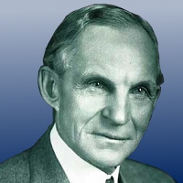 |
 |
 |
 |
 |
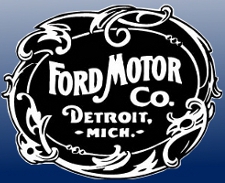 |
